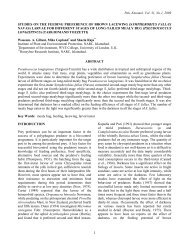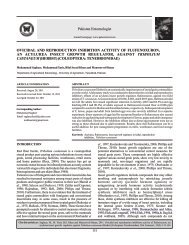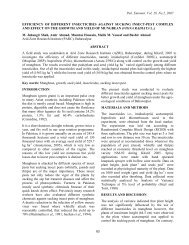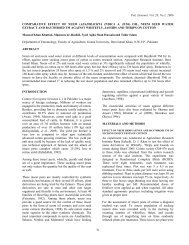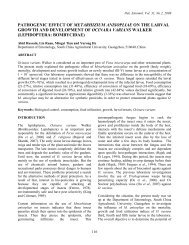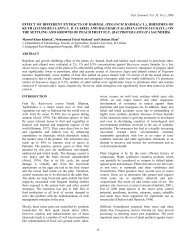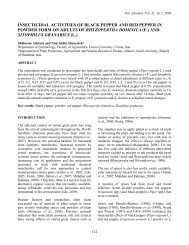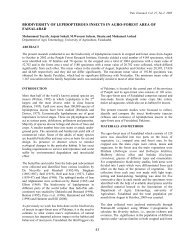seasonal incidence and biology of sapota seed borer, trymalitis ...
seasonal incidence and biology of sapota seed borer, trymalitis ...
seasonal incidence and biology of sapota seed borer, trymalitis ...
You also want an ePaper? Increase the reach of your titles
YUMPU automatically turns print PDFs into web optimized ePapers that Google loves.
Pak. Entomol. Vol. 31, No.2, 2009SEASONAL INCIDENCE AND BIOLOGY OF SAPOTA SEED BORER,TRYMALITIS MARGARIAS MEYRICKAbhishek ShuklaFruit Research Station, Navsari agricultural University, G<strong>and</strong>evi-396 360, Gujarat, IndiaABSTRACTThe <strong>seasonal</strong> <strong>incidence</strong> <strong>and</strong> life cycle <strong>of</strong> Sapota <strong>seed</strong> <strong>borer</strong>, Trymalitis margarias Meyrick was determined in thepresent study in field <strong>and</strong> laboratory, respectively. The <strong>seasonal</strong> in <strong>sapota</strong> <strong>seed</strong> <strong>borer</strong>, Trymalitis margariasMeyrick revealed that the larval population fluctuated throughout the year with two peak period <strong>of</strong> infestationi.e., October in 2007-08 <strong>and</strong> November in 2008-09, respectively. The <strong>biology</strong> <strong>of</strong> T. margarias indicated that thefemale moth laid 161.8±77.236 eggs. The average pre-oviposition, oviposition <strong>and</strong> post-oviposition periodlasted for 1.83±0.185, 1.44±0.373 <strong>and</strong> 1.61±0.443 days, respectively. The duration <strong>of</strong> egg, larval <strong>and</strong> pupalstages lasted for an average <strong>of</strong> 11.16±0.715, 12.33±0.832 <strong>and</strong> 13.15±1.663 days, respectively. The adult male<strong>and</strong> female survived for a period <strong>of</strong> 4.125±0.690 <strong>and</strong> 4.865±0.971 days, respectively. The total life cycle fromegg laying to adult emergence complete in 38.50±3.117 days.Key words: <strong>sapota</strong> <strong>seed</strong> <strong>borer</strong>, T. margarias, <strong>seasonal</strong> <strong>incidence</strong>, <strong>biology</strong>.INTRODUCITONSapota or Sapodilla (Manilkara achras (Mill)Forsberg) commonly known as “chiku” belongs t<strong>of</strong>amily Sapotaceae. Sapota is a native <strong>of</strong> Mexico <strong>and</strong>spread to other countries. The fruit was introducedduring 1888 in a village Gholwad <strong>of</strong> Thane district <strong>of</strong>Maharashtra in India (Cheema et al., 1954). Atpresent, Sapota cultivation is confined mostly to thecoastal areas <strong>of</strong> Gujarat, Maharashtra <strong>and</strong> TamilNadu(Bose, 1985). In Gujarat, this fruit crop plays asignificant role in socio-economic upliftment <strong>of</strong> bothmarginal <strong>and</strong> big farmers. Moreover, its orchards canbe developed comparatively with fewer efforts aswell as the marketing facilities are also welldeveloped by co-operative societies <strong>of</strong> farmersespecially in South Gujarat. Presently, 14885 ha isunder Sapota cultivation with 138592 MTproduction. In South Gujarat especially Valsad,Navsari <strong>and</strong> Surat Districts, the area under this cropis 7169 ha which comprises 48 per cent <strong>of</strong> the totalarea <strong>of</strong> the state (Anonymous, 2000). Sapota tree isattacked by about 16 insect pests (Marin-Acosta,1975), which includes bud <strong>borer</strong>, chiku moth, leafminer <strong>and</strong> fruit flies (Deshmukh, 2001). A new pest,<strong>sapota</strong> <strong>seed</strong> <strong>borer</strong>, Trymalitis margarias Meyrick(Lepidoptera: Tortricidae) has appeared in the area<strong>and</strong> causing very serious damage. This pestexclusively feeds on endosperm <strong>of</strong> the <strong>seed</strong>. Fullgrown larvae prepare a tunnel to come out from thefruit for pupation. Through this exit hole the fungusas well as ants enters inside the fruits <strong>and</strong> the fruitbecomes unfit for consumption. As high as 40 to 80per cent damage to the mature fruits have beennoticed. Due to the infestation <strong>of</strong> this pest, quality <strong>of</strong>the fruit deterorates <strong>and</strong> hence the market price goesdown <strong>and</strong> farmers also lose their goodwill in themarket. Keeping in view growing importance <strong>of</strong>pests, <strong>seasonal</strong> <strong>incidence</strong> <strong>and</strong> <strong>biology</strong> <strong>of</strong> T. margariason <strong>sapota</strong> cv Kalipatti, was studied.MATERIALS AND METHODSSeasonal <strong>incidence</strong>: To study the <strong>seasonal</strong> <strong>incidence</strong><strong>of</strong> Sapota <strong>seed</strong> <strong>borer</strong>, ten medium sized trees <strong>of</strong>Sapota were selected r<strong>and</strong>omly at Sapota orchard <strong>of</strong>Fruit Research Station, Navsari AgriculturalUniversity, G<strong>and</strong>evi, Gujarat, India <strong>and</strong> permanentlymarked with white paint for recording theobservations. No insecticidal measures were taken inthe field selected for present studies during the entireperiod <strong>of</strong> study i.e., April 2007 to March 2009. Everymonth the fruits harvested from each marked treewere examined for infestation <strong>of</strong> Sapota <strong>seed</strong> <strong>borer</strong>.The damaged <strong>and</strong> healthy fruits were counted at eachharvest to work out the per cent fruit damage.Biology <strong>of</strong> Sapota <strong>seed</strong> <strong>borer</strong>: The <strong>biology</strong> <strong>of</strong> T.margarias was studied in the laboratory at roomtemperature <strong>and</strong> relative humidity at Fruit Research107
Pak. Entomol. Vol. 31, No.2, 2009Station, Navsari Agricultural University, G<strong>and</strong>evi,Gujarat, India during 2008-09. The initial culture wasobtained by collecting larval stages from the infestedfruits <strong>of</strong> Sapota from orchards in the vicinity <strong>and</strong>reared in the laboratory in the glass jars. Fresh <strong>seed</strong>kernels were provided to the larvae as food till thelarvae become full grown <strong>and</strong> ready to undergopupation. The freshly emerged female <strong>and</strong> two maleswere sexed <strong>and</strong> released for mating <strong>and</strong> ovipositionon a fresh shoot <strong>of</strong> Sapota with a fruit whose stemwas kept dipped in 100 ml conical flask filled withwater <strong>and</strong> covered with a polythene cage <strong>of</strong> 40 x60 x100 cm.The top <strong>of</strong> the cage was covered with muslin cloth<strong>and</strong> secured firmly with rubber b<strong>and</strong>. Cotton swabsoaked in 5 per cent honey solution was keptsuspended as adult food. The Sapota fruits werechanged daily. Twenty such sets were kept underobservation for egg laying. The freshly laid eggs onSapota fruits were collected by wet camel hair brush<strong>and</strong> placed in petriplates (9 cm diameter) with apiece <strong>of</strong> wet blotting paper at its bottom. Thirtyindividuals <strong>of</strong> larvae were transferred on tender <strong>seed</strong>s<strong>of</strong> Sapota cv kalipatti. The larval food was changed atan alternate day till the feeding cease. The larvaewere observed carefully for moulting, pre pupation<strong>and</strong> pupation. Accordingly larval <strong>and</strong> pupal periods<strong>and</strong> their measurements were recorded. The periodfrom emergence <strong>of</strong> adult to its death was worked outto note adult longevity. The sex ratio was alsodetermined by counting the number <strong>of</strong> male <strong>and</strong>female adults emerged from 50 pupae reared onSapota <strong>seed</strong> kernel.RESULTS AND DISCUSSIONSeasonal <strong>incidence</strong> The per cent fruit infestation(Table 1) revealed that the infestation fluctuatedthroughout the year, but intensity varied duringdifferent months. During 2007-08 the <strong>incidence</strong> <strong>of</strong>this pest was at it peak in October with 10.50 per centfruit infestation, while in year 2008-09 the highestfruit infestation was recorded in the month <strong>of</strong>November which was 7.00 per cent fruit infestation.Thereafter it declined <strong>and</strong> reached only 1.5 per centin January 2007-08 <strong>and</strong> 0.5 per cent in February2008-09, respectively. The data revealed that the pesthas one peak in a year i.e., in October or November<strong>of</strong> certain years (2007-08, 2008-09). The peakcorresponds to the crop harvesting periods.Table 1. Seasonal <strong>incidence</strong> <strong>of</strong> <strong>sapota</strong> <strong>seed</strong><strong>borer</strong>, T. margariasMonth &weekPer centinfested fruitMonth &weekPer centinfested fruitApril-07 I 0.00 April-08 I 0.00II 0.00 II 0.00May-07 I 4.00 May-08 I 0.00II 5.50 II 1.50June-07 I 4.00 June-08 I 2.00II 0.00 II 1.00July-07 I 0.00 July-08 I 0.00II 0.00 II 0.00Aug.-07 I 0.00 Aug.-08 I 0.00II 0.00 II 0.00Sept.-07 I 5.50 Sept.-08 I 2.50II 6.00 II 3.00Oct.-07 I 10.50 Oct.-08 I 4.50II 9.00 II 5.00Nov.-07 I 9.00 Nov.-08 I 7.00II 6.00 II 3.50Dec.-07 I 10.00 Dec.-08 I 3.50II 6.00 II 4.00Jan.-08 I 4.00 Jan.-09 I 2.00II 1.50 II 2.00Feb.-08 I 0.00 Feb.-09 I 0.50II 0.00 II 0.00Mar.-08 I 0.00 Mar.-09 I 0.00II 0.00 II 0.00Biology <strong>of</strong> Sapota <strong>seed</strong> <strong>borer</strong> The mating <strong>of</strong> male<strong>and</strong> female moths was observed during evening hoursbetween 7.00 to 11.00 p.m. <strong>and</strong> the period <strong>of</strong> coituslasted for 8 to 13 minutes. The pre-oviposition,oviposition <strong>and</strong> post-oviposition period lasted for1.50 to 2.1, 1.0 to 2.0 <strong>and</strong> 1.0 to 2.2 days,respectively. The fecundity was ranged from 29 to255 with an average 161.8±77.236 eggs per female.The incubation period varied from 10.35 to 12.25days with an average <strong>of</strong> 11.16 ± 0.715 (Table-2). Theaverage percentage <strong>of</strong> eggs hatched was found to be92. The total period required for completion <strong>of</strong> larvaldevelopment ranged from 10.75 to 13.75 days withan average <strong>of</strong> 12.33 ± 0.832 days. The first instarlarvae were very minute, white in colour with pinkishtinge, without distinctly segmented <strong>and</strong> hairless body.The average length <strong>and</strong> breadth <strong>of</strong> first instar larvawas 1.761 ± 0.038 <strong>and</strong> 0.692 ± 0.012 mm,respectively. Fully developed larvae was pinkish incolour <strong>and</strong> it measured about 12.467 ±0.022 mm in108
Pak. Entomol. Vol. 31, No.2, 2009length <strong>and</strong> 2.673 ± 0.013 mm in breadth. The fullgrown larva stopped feeding come out <strong>of</strong> the <strong>seed</strong><strong>and</strong> started folding the leaf with the help <strong>of</strong> series <strong>of</strong>silken threads to form a cocoon. The pre-pupal periodvaried from 17 to 33 minutes. The pupa was small,dark brown in colour <strong>and</strong> obtect. The pupal periodranged from 10.0 to 15.0 days with an average <strong>of</strong>13.15 ± 1.663 days. The pupa measured from 7.61 to10.10 mm in length <strong>and</strong> 2.6 to 3.6 mm in breadth.The adult moths were small in size, having whitishforewings with grayish spots on it <strong>and</strong> fringed withhairs at the margins <strong>of</strong> the wings. The hind wingswere cream coloured with thick hairs at the margins.The adult measured 7.1 to 12.0 mm in length, 2.1 to2.6 mm in breadth. The adult male lived for 3.25 to6.0 days, while female moths lived for 4.0 to 7.0days. Total life cycle from egg laying to emergence<strong>of</strong> adults varied from 34.10 to 45.0 days with anaverage <strong>of</strong> 38.5 ± 3.117 days.Table 2. Life cycle <strong>of</strong> <strong>sapota</strong> <strong>seed</strong> <strong>borer</strong>, T.margariasDuration in daysParticulars Maximum Minimum MeanEgg period 10.35 12.25 11.16±0.715Larval period 10.75 13.75 12.33±0.832Pupal period 10.00 15.00 13.15±1.663Pre-ovipositionperiod1.50 2.10 1.83±0.185Ovipositionperiod1.00 2.00 1.44±0.373Post-ovipositionperiod1.0 2.2 1.61±0.443Adult longevityMale3.25 6.0 4.12±0.690Adult longevityFemale4.0 7.0 4.86±0.971Total life cycle 34.10 45.0 38.50±0.311Sex ratio -- -- 1:1.20Fecundity (No.<strong>of</strong> eggs laid perfemale)29 255 161.80±77.24Table 3. Morphometric measurements <strong>of</strong><strong>sapota</strong> <strong>seed</strong> <strong>borer</strong>, T. margariasMeasurement in mmParticulars Maximum Minimum MeanI instar larvaelength1.70 1.79 1.761±0.038I instar larvaebreadth0.69 0.71 0.692±0.012Full maturelarvae length12.44 12.50 12.47±0.022Full maturelarvae breadth2.65 2.69 2.673±0.013Pupal length 7.61 10.10 9.143±0.920Pupal breadth 2.6 3.6 3.090±0.458Adult length 7.1 12.0 9.940±1.860Adult breadth 2.1 2.6 2.280±0.248PLATE-1. Fully grown larvae109
Pak. Entomol. Vol. 31, No.2, 2009PLATE-1. Pupation <strong>of</strong> <strong>sapota</strong> <strong>seed</strong> <strong>borer</strong>PLATE:5 Damaged <strong>sapota</strong> fruitREFERENCESPLATE: 3 Adult moth <strong>of</strong> <strong>sapota</strong> <strong>seed</strong> <strong>borer</strong>Anonymous, 2000. District wise estimated data inarea <strong>and</strong> production <strong>of</strong> fruit crop in Gujarat Stateduring 1998-99, Directorate <strong>of</strong> Horticulture,Gujarat State, Ahmedabad, 221 p.Bose, T. K., 1985. Fruits <strong>of</strong> India, Tropical <strong>and</strong> Subtropical.Naya Prakash, Culcutta, India, pp.87-94.Cheema, G. S., S. S. Bhatt <strong>and</strong> K. C. Naik, 1954.Commercial fruits <strong>of</strong> India. Macmillan <strong>and</strong> Co.,422 p.Deshmukh, D. V., 2001. Varietal screening <strong>of</strong> <strong>sapota</strong>against pest complex, comparative <strong>biology</strong> <strong>of</strong>Anarsia achrasella Bradley <strong>and</strong> bio-efficacy <strong>of</strong>chemical insecticides against bud boring insects<strong>of</strong> <strong>sapota</strong>. M. Sc. (Ag) Thesis. Gujarat Agric.Univ., S. K. Nagar, India.Marin-Acosta, J., 1975. Preliminary list <strong>of</strong> pests <strong>of</strong>Annonaceae <strong>and</strong> Sapodilla <strong>and</strong> Guava inVenezela. Agron. Trop., 23(2): 205-216.PLATE:4 Damaged <strong>seed</strong> kernel <strong>of</strong> <strong>sapota</strong>110



